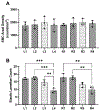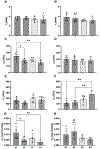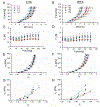Longitudinal histomechanical heterogeneity of the internal thoracic artery
- PMID: 33476887
- PMCID: PMC7933128
- DOI: 10.1016/j.jmbbm.2021.104314
Longitudinal histomechanical heterogeneity of the internal thoracic artery
Abstract
The internal thoracic artery (ITA) is the principal choice for coronary artery bypass grafting (CABG) due to its mechanical compatibility, histological composition, anti-thrombogenic lumen, and single anastomotic junction. Originating at the subclavian artery, traversing the thoracic cavity, and terminating at the superior epigastric and musculophrenic bifurcation, bilateral ITAs follow a protracted circuitous pathway. The physiological hemodynamics, anatomical configuration, and perivascular changes that occur throughout this length influence the tissue's microstructure and gross mechanical properties. Since histomechanics play a major role in premature graft failure we used inflation-extension testing to quantify the regional material and biaxial mechanical properties at four distinct locations along the left (L) and right (R) ITA and fit the results to a structurally-motivated constitutive model. Our comparative analysis of 44 vessel segments revealed a significant increase in the amount of collagen but not smooth muscle and a significant decrease in elastin and elastic lamellae present with distance from the heart. A subsequent decrease in the total deformation energy and isotropic contribution to the strain energy was present in the LITA but not RITA. Circumferential stress and compliance generally decreased along the length of the LITA while axial stress increased in the RITA. When comparing RITAs to LITAs, some morphological and histological differences were found in proximal sections while distal sections revealed differences predominantly in compliance and axial stress. Overall, this information can be used to better guide graft selection, graft preparation, and xenograft-based tissue-engineering strategies for CABG.
Keywords: Bypass grafting; Internal mammary; Porcine xenograft; Vascular mechanics.
Copyright © 2021 Elsevier Ltd. All rights reserved.
Conflict of interest statement
Declaration of interests
The authors declare that they have no known competing financial interests or personal relationships that could have appeared to influence the work reported in this paper.
Figures










Similar articles
-
Bilateral internal thoracic artery grafting: Does graft configuration affect outcome?J Thorac Cardiovasc Surg. 2016 Jul;152(1):120-7. doi: 10.1016/j.jtcvs.2016.03.022. Epub 2016 Mar 12. J Thorac Cardiovasc Surg. 2016. PMID: 27343909
-
Reusing the patent internal mammary artery as a conduit in redo coronary artery bypass surgery.Interact Cardiovasc Thorac Surg. 2016 Mar;22(3):346-50. doi: 10.1093/icvts/ivv338. Epub 2015 Dec 15. Interact Cardiovasc Thorac Surg. 2016. PMID: 26669852 Free PMC article. Review.
-
The right internal thoracic artery graft--benefits of grafting the left coronary system and native vessels with a high grade stenosis.Eur J Cardiothorac Surg. 2000 Sep;18(3):255-61. doi: 10.1016/s1010-7940(00)00527-3. Eur J Cardiothorac Surg. 2000. PMID: 10973532
-
The Growth Potential and Patency of Free Right Internal Thoracic Arteries Verified by Computed Tomography Angiography.Ann Thorac Surg. 2021 Dec;112(6):1990-1996. doi: 10.1016/j.athoracsur.2021.01.015. Epub 2021 Jan 20. Ann Thorac Surg. 2021. PMID: 33484672
-
Does a skeletonized internal thoracic artery give fewer postoperative complications than a pedicled artery for patients undergoing coronary artery bypass grafting?Interact Cardiovasc Thorac Surg. 2015 May;20(5):663-8. doi: 10.1093/icvts/ivv026. Epub 2015 Feb 24. Interact Cardiovasc Thorac Surg. 2015. PMID: 25712987 Review.
Cited by
-
Small-diameter artery decellularization: Effects of anionic detergent concentration and treatment duration on porcine internal thoracic arteries.J Biomed Mater Res B Appl Biomater. 2022 Apr;110(4):885-897. doi: 10.1002/jbm.b.34969. Epub 2021 Dec 2. J Biomed Mater Res B Appl Biomater. 2022. PMID: 34855280 Free PMC article.
-
Acute Mechanical Consequences of Vessel-Specific Coronary Bypass Combinations.Cardiovasc Eng Technol. 2023 Jun;14(3):404-418. doi: 10.1007/s13239-023-00661-7. Epub 2023 Feb 24. Cardiovasc Eng Technol. 2023. PMID: 36828977
References
-
- Baek S, Gleason RL, Rajagopal KR, Humphrey JD, 2007. Theory of small on large: potential utility in computations of fluid-solid interactions in arteries . Comput. Methods Appl. Mech. Eng 196, 3070–3078.
-
- Bedi HS, Sharma VK, Kler TS, T. N, 1995. Coronary-to-Coronary Bypass Using a Free Internal Mammary: An Alternative. Ann. Thorac. Surg 4975, 757–759. - PubMed
Publication types
MeSH terms
Grants and funding
LinkOut - more resources
Full Text Sources
Other Literature Sources

